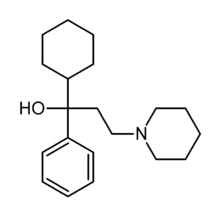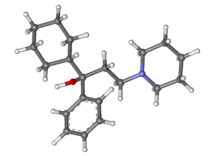Trihexyphenidyl
 |
|
 |
|
| Clinical data | |
|---|---|
| AHFS/Drugs.com | Monograph |
| MedlinePlus | a682160 |
| Pregnancy category |
|
| Routes of administration |
Oral, as tablet or elixir |
| ATC code | N04AA01 (WHO) |
| Legal status | |
| Legal status |
|
| Pharmacokinetic data | |
| Biological half-life | 3.3-4.1 hours |
| Identifiers | |
|
|
| CAS Number |
144-11-6 |
| PubChem (CID) | 5572 |
| IUPHAR/BPS | 7315 |
| DrugBank |
DB00376 |
| ChemSpider |
5371 |
| UNII |
6RC5V8B7PO |
| KEGG |
D08638 |
| ChEMBL |
CHEMBL1490 |
| ECHA InfoCard | 100.005.105 |
| Chemical and physical data | |
| Formula | C20H31NO |
| Molar mass | 301.466 g/mol |
| 3D model (Jmol) | Interactive image |
|
|
|
|
Trihexyphenidyl (Artane, Apo-Trihex, Parkin, Pacitane), also known as benzhexol and trihex, is an antiparkinsonian agent of the antimuscarinic class. It has been in clinical usage for decades.
The exact mechanism of action in parkinsonian syndromes is not precisely understood, but it is known that trihexyphenidyl blocks efferent impulses in parasympathetically innervated structures like smooth muscles (spasmolytic activity), salivary glands, and eyes (mydriasis). In higher doses direct central inhibition of cerebral motor centers may contribute. In very high doses central toxicity as seen in atropine overdose is noted.
It binds to the M1 muscarinic receptor and possibly the dopamine receptor.
Trihexyphenidyl is rapidly absorbed from the gastrointestinal tract. The onset of action is within 1 hour after oral dosing. The peak activity is noted after 2 to 3 hours. The duration of action of one single dose is 6 to 12 hours in a dose dependent manner. It is excreted in the urine, probably as unchanged drug. More precise data in animals and humans have so far not been determined.
Trihexyphenidyl is used for the symptomatic treatment of Parkinson's disease in mono- and combination therapy. It is active in postencephalitic, arteriosclerotic, and idiopathic forms. The drug is also commonly used to treat extrapyramidal side effects occurring during antipsychotic treatment. It reduces the frequency and duration of oculogyric crises as well as of dyskinetic movements and spastic contractions. Excessive salivation may also respond. Trihexyphenidyl may improve psychotic depression and mental inertia frequently associated with Parkinson's disease and symptomatic problems caused by antipsychotic treatment.
The drug cannot cure Parkinson's disease, but may provide substantial alleviation of symptoms. An estimated 50 to 75% of patients with Parkinson's disease will react positively and experience a 20 to 30% symptomatic improvement. To increase therapeutic activity trihexyphenidyl is often given concomitantly with levodopa, other antimuscarinic or antihistaminic (e.g. diphenhydramine) agents. Combination treatment with dopaminergic agonists such as cabergoline is also possible. This is often termed a 'multidimensional approach'.
...
Wikipedia
